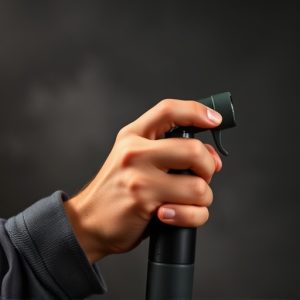Pepper Spray Management: Storage, Shelf Life for Law Enforcement
Proper pepper spray storage and shelf life are critical for law enforcement agencies to maintain the…….
Proper pepper spray storage and shelf life are critical for law enforcement agencies to maintain the effectiveness and safety of these riot control agents. According to guidelines, pepper spray should be stored in cool, dry areas away from direct sunlight or extreme temperatures, using secure lockable cabinets or vehicle compartments. Regular inventory audits, expiration date checks, and testing ensure officers have access to potent riot control measures when needed, enhancing operational readiness and officer safety.
Riot control agents, such as pepper spray, are essential tools for law enforcement agencies worldwide. This article delves into the critical role these agents play in maintaining public safety during civil unrest and high-risk situations. We explore different types of riot control agents, their storage guidelines to ensure effectiveness and safety, and important shelf life considerations. Understanding these aspects is crucial for effective deployment and optimal utilization by law enforcement. Learn about best practices for managing pepper spray storage and replacement timelines.
- Understanding Riot Control Agents: Types and Their Role in Law Enforcement
- Pepper Spray Storage Guidelines: Ensuring Safety and Effectiveness
- Shelf Life Considerations: When to Replace Riot Control Agents
Understanding Riot Control Agents: Types and Their Role in Law Enforcement
Riot control agents, also known as less-lethal weapons, are chemical substances designed to disrupt and disperse crowds without causing permanent harm. These agents play a significant role in law enforcement, providing an essential tool for managing civil disturbances, protests, and high-risk situations. The most common type is pepper spray, which temporarily disables individuals by irritating the eyes, nose, and respiratory system.
There are various types of riot control agents, each with unique properties and applications. Besides pepper spray, other commonly used substances include tear gas (a.k.a. chloroacetophenone or CN gas), pepper ball guns, and rubber bullets. The choice of agent depends on the nature of the disturbance, crowd behavior, and tactical considerations. Proper storage and handling are crucial for maintaining the effectiveness and safety of these agents. For instance, pepper spray has a specific shelf life and requires cool, dry conditions to preserve its potency. Understanding these factors is vital for law enforcement agencies to ensure their riot control arsenal remains ready and reliable when needed.
Pepper Spray Storage Guidelines: Ensuring Safety and Effectiveness
Proper storage of pepper spray is paramount for law enforcement agencies to ensure its safety, shelf life, and ultimate effectiveness during operations. According to guidelines, pepper spray should be stored in a cool, dry place away from direct sunlight or extreme temperature fluctuations. Ideal storage locations include secure lockable cabinets or compartments within vehicles, ensuring minimal exposure to moisture and heat. Additionally, storing pepper spray separately from any combustible materials is crucial to prevent accidental ignitions.
When it comes to shelf life, pepper spray manufacturers typically provide specific recommendations. Regularly checking expiration dates and inspecting the product for signs of damage or degradation is essential. Contaminants like dust or moisture can render the spray less potent over time, so maintaining a clean storage environment further guarantees optimal performance when needed by officers in the field.
Shelf Life Considerations: When to Replace Riot Control Agents
Riot control agents, including pepper spray, are essential tools for law enforcement dealing with crowd control scenarios. However, like any chemical substance, they have a finite shelf life and require proper storage to maintain their effectiveness. The storage and shelf life of pepper spray are crucial factors that determine its readiness for use when needed.
Regularly checking the expiration dates and conducting inventory audits are vital practices. Pepper spray starts to degrade over time due to various environmental factors such as heat, light, and moisture. Exposure to these elements can significantly impact its potency and performance. Therefore, law enforcement agencies should establish strict protocols for pepper spray storage, keeping them in secure, cool, dry places away from direct sunlight. Additionally, regular testing of stock is recommended to ensure the agents remain potent, ensuring officers have access to reliable riot control measures during operations.
Riot control agents, such as pepper spray, are powerful tools for law enforcement, but their effective use relies on proper storage and timely replacement. By adhering to recommended storage guidelines and understanding shelf life, officers can ensure these agents remain safe, reliable, and ready when needed. Responsible management of pepper spray not only maximizes its effectiveness in crowd control but also prioritizes the safety of both officers and citizens.


